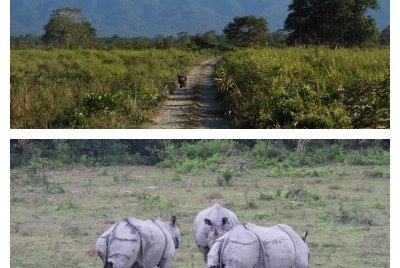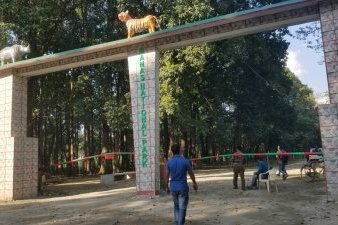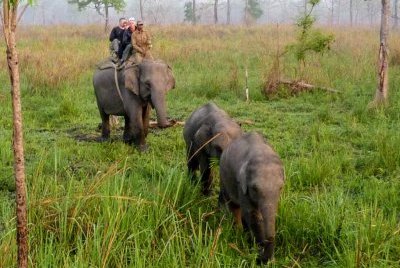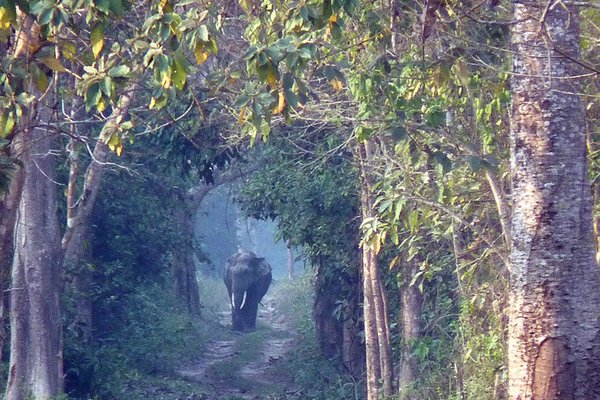India
Manas Wildlife Sanctuary
The Manas Wildlife Sanctuary in the Himalayan foothills is known for its tiger, elephant and rhino populations.
The sanctuary lies in a scenic landscape of rivers, forested hills, and grasslands. The Manas River is a major tributary of the Brahmaputra, constantly shaping the land. The site provides critical and viable habitats for rare and endangered species, including tigers, greater one-horned rhinos, swamp deer, and pygmy hogs. Some 500 species of birds have been recorded.
Community Perspective: Solivagant has described this site’s recent ill-fated history, while “back in the early 80’s, Manas was something of a jewel in India’s wildlife crown. Zoë (2018) reported “It's almost like all the animals ran away up north”, while Els (2024) noticed some improvements although it still only stands in the shadow of Kaziranga.
Site Info
Official Information
- Full Name
- Manas Wildlife Sanctuary (ID: 338)
- Country
- India
- Status
-
Inscribed 1985
Site history
History of Manas Wildlife Sanctuary
- 2011: Removed from Danger list
- 1992: In Danger
- damage caused by the invasion of this Sanctuary by militants from the Bodo tribe
- 1985: Inscribed
- Inscribed
- Type
- Natural
- Criteria
- vii
- ix
- x
Links
- UNESCO
- whc.unesco.org
- Official
-
- manasnptr.in — Manas National Park & Tiger Reserve
- Related
-
- manastigerreserve.in — Manas Tiger Reserve
- mapsofindia.com — Maps of India shows practical info (last updated 2015)
All Links
UNESCO.org
- whc.unesco.org — whc.unesco.org/
Official Website
- manasnptr.in — Manas National Park & Tiger Reserve
Related Resources
- manastigerreserve.in — Manas Tiger Reserve
- mapsofindia.com — Maps of India shows practical info (last updated 2015)
News Article
- May 8, 2025 hubnetwork.in — Elephant poaching in Assam’s World Heritage Manas Park sparks concern
- Nov. 3, 2016 nyoooz.com — Tiger skin recovered, four arrested in Manas National Park
- May 8, 2016 timesofindia.indiatimes.com — Poachers kill a rhino in Assam's Manas national park
- Nov. 2, 2014 timesofindia.indiatimes.com — Manas rhino killed
- Oct. 19, 2014 assamtribune.com — Encroachment poses threat to Manas National Park
- Oct. 31, 2013 zeenews.india.com — Rhino killed in Manas National Park
- Feb. 21, 2012 thehindu.com — Manas gets four more rhinos
- Oct. 18, 2011 timesofindia.indiatimes.com — Manas runaway rhino might have been killed
- June 23, 2011 timesofindia.indiatimes.com — After nearly two decades, Manas National Park has got rid of the danger tag that was attached to it by the Unesco's World Heritage Committee way back in 1992
- June 12, 2011 telegraphindia.com — Jumbo sighting boost for Manas
- April 9, 2010 redorbit.com — An endangered Royal Bengal tiger that strayed near a village in Assam, India was rescued early last week and later released in Manas National Park, becoming the first tiger released to the wild in this World Heritage Site.
- Nov. 3, 2009 assamtribune.com — Reopening of Manas postponed
- Oct. 21, 2009 ptinews.com — Bhutan's help sought for restoring Manas National Park
- May 31, 2008 telegraphindia.com — The World Heritage Committee of Unesco may finally consider taking the Heritage Site in Danger tag off Manas National Park with the park authorities fulfilling one of the UN agency's conditions: they have submitted the baseline data of the park
- April 14, 2008 assamtribune.com — Two male rhinos released in Manas
- Feb. 21, 2008 zeenews.com — A four-member team of UNESCO`s World Heritage Committee recently visited the Manas National Park, and expressed satisfaction with the measures taken by the forest department to strengthen infrastructure and security measures there.
- Nov. 21, 2007 assamtribune.com — The picturesque Manas National Park, currently on the recovery path after a decade-long turmoil in the 1990s, is desperately hoping to get back the World Heritage Site tag. The decade of social unrest during the height of the Bodoland movement caused substantial damage to its infrastructure besides taking a heavy toll on the wildlife.
- April 2, 2007 telegraphindia.com — Manas regaining lost ground, says survey - Recent assessment recommends restoring heritage site status to national park
Community Information
- Community Category
- Wildlife habitat: Fauna
Travel Information
Seasonal WHS
Recent Connections
-
Golden jackal
-
Strepsirrhini
Slow loris (wiki)
-
Named after a River
Manas River
Connections of Manas Wildlife Sanctuary
- Geography
-
-
Brahmaputra Basin
The Manas River flows into the Brahmaputra -
Himalaya
“Manas is located at the foothills of the Eastern Himalayas” (OUV), and “it is intricately linked to the Himalayas, including through the Manas River” (ICIMOD study 2021) -
On National Border
On Bhutan border
-
- Trivia
-
-
Total Solar Eclipse since Inscription
21/22 July, 2009
-
- Ecology
-
-
Critically endangered fauna species
Bengal florican, a type of bustard (< 1,000 individuals remaining) -
Eagles
fishing eagles, crested serpent-eagles (wiki) -
Elephants
Asian elephant (Indian elephant) -
Multiple biogeographic realms
At the junction of Indo-Malayan and Palaearctic realms -
Over 300 bird species
350 species of birds (AB) -
Pelicans
spot-billed pelicans -
Rhino habitat
Indian one-horned rhino -
Tiger habitat
-
Turtles and tortoises
Habitat of Assam Roofed Turtle, sawbacked terrapin and eastern hill terrapin -
Strepsirrhini
Slow loris (wiki)
-
Endemic Bird Species
Assam Plains EBA, Manas IBA: Marsh Babbler (Pellorneum palustre), Black-breasted Parrotbill (Paradoxornis flavirostris) -
River Dolphins
South Asian river dolphin (UNEP-WCMC) -
Bovines
Gaur (Indian Bison) -
Swamps and Marshes
"The monsoon and river system form four principal geological habitats: Bhabar savannah, Terai tract, marshlands and riverine tracts." (OUV) -
Golden jackal
-
Bears
Sloth bear Melursus ursinus (VU), black bear Selenarctos thibetanus (VU) (= Vulnerable IUCN) -
Reintroduced Species
"The entire population of one-horned rhinos decreased from around 100 at the time of the inscription of the property in 1985 to zero in 2001, primarily due to poaching during a time of political unrest. A programme to re-introduce the rhino back into Manas began in 2006 with one individual (State Party of India, 2011), and between 2008 and 2012, 18 further rhinos were reintroduced in the site through wildto-wild translocation from Kaziranga and Pobitora. In addition, 17 rescued and rehabilitated rhinos from the wild animal rescue facility in Kaziranga were also released here between 2006 and 2019." (IUCN Outlook 2020) -
Pangolin
Chinese pangolin (wiki)See en.wikipedia.org
-
- Damaged
-
-
Poaching
no rhino poaching since 2017 due to harsh measures but tiger poaching and sambar hunting existsSee en.wikipedia.org
-
'Threatened' by Dams
Kurichhu Dam on Manas River and Mangdecchu Dam on Mangde Chhu River, a tributary of the Manas, in Bhutan will affect the Site
-
- World Heritage Process
-
-
Extension Supported
"The Committee furthermore encouraged the Government of Bhutan to adhere to the World Heritage Convention and to nominate the contiguous Manas Wildlife Sanctuary in Bhutan which could then form a transfrontier World Heritage property." (Decision 9 COM X.A) -
Extensions on Tentative List
Bhutan's "Royal Manas NP" -
Former In Danger List sites
1992-2011 -
Perfect Inscriptions
1985 -
Potential Transboundary sites
Bhutan's "Royal Manas NP"
-
- Religion and Belief
-
-
Goddesses
The name of the park is originated from the Manas River, which is named after the serpent goddess Manasa. (Wiki)
-
- Human Activity
-
-
Royal Hunting Grounds
The area was initially the hunting grounds of the Maharaja of Cooch Behar and the Raja of Gauripur. It was declared a protected area - Manas Sanctuary, as early as 1928, but the hunting rights of the royal families were not revoked. The sanctuary finally turned fully protected when it became a Tiger Reserve in 1973, and a national park in 1990.
-
- WHS on Other Lists
-
-
Biodiversity hotspot
Eastern Himalaya, Nepal -
Alliance for Zero Extinction
Porcula salvania (Pygmy Hog) -
Plant WHS not in a CPD
"accounts for high plant diversity that includes 89 tree species, 49 shrubs, 37 undershrubs, 172 herbs and 36 climbers" (OUV) -
World Heritage Forest Programme
-
- Timeline
-
-
Holocene
The course of the Manas river formed in the Holocene and continued to change as late as the 20th century.See en.wikipedia.org
-
- Visiting conditions
-
-
Seasonal WHS
Usually open from October to May, depending on the monsoon.
-
- WHS Names
-
-
Named after a River
Manas River
-
News
- hubnetwork.in 05/08/2025
- Elephant poaching in Assam’s World…
- nyoooz.com 11/03/2016
- Tiger skin recovered, four arreste…
- timesofindia.indiatimes.com 05/08/2016
- Poachers kill a rhino in Assam's M…
Community Reviews
Show full reviews
Manas is a fine excuse to make the detour to northwestern Assam. According to these stats, only a couple of hundred foreign tourists make it to the park in a good year. I went there by car+driver from Kaziranga (6.5 hours) and stayed for 2 nights in a homestay amidst the tea fields close to the Bansbari park entrance. All was calm, friendly and very low-key. It reminded me of rural Thailand, the area where I stayed to visit Huai Kha Khaeng.
The scenery is dominated by the massive “wall” of the Himalayas which lie north of the flat lands of Manas. Another characteristic is the presence of a lot of dense forest. There are other park entrances as well, Bhuyanpara and Panbari, which lie more to the east and west respectively: the east is where you can find the most special mammal species of Manas, the pygmy hog (although they are “almost never seen”).
I did two jeep safaris in the park from the Bansbari gate: one from 6-9 a.m. and the other from 2-5 p.m. The early morning one seemed to be the most fruitful as it delivered about one specimen of each of the common species (Indian rhino, Asian elephant, Asian water buffalo, Malayan giant squirrel, Sambar deer, Capped langur), plus numerous Indian peacocks. That was until we ended our afternoon tour at 4.30 with a visit to the Bura Burithai Watchtower: at its clearing we saw 2 gaur and 5 rhinos simultaneously and …
Keep reading 0 comments
Have you ever wanted to go to Bhutan but were put off by the high fees (which aren't really that high if you think about it being all inclusive but anyway)? Well you can go to Bhutan for free! But there is a catch. You need to a) go to India, b) visit Manas NP, and lastly c) ask/persuade your guide to take you across the border. The border is less than an hour from the park entrance near the park ranger quarters but there are no border guards, no passport checks, there is a small hut and an open gate so maybe it is used sometimes or it was used before. Okay for one this ain't Paro so you will not continue to the Tiger's Nest on this trip. Second you will not see much because the guide won't risk taking you far in.
To get to Manas I took the train from NJP after returning from Darjeeling. It takes a good 6 hours but I find the 2AC beds adequate to nap and have enough space to feel luxurious. The Indian police also eradicated the peddlers a couple of times and it was quiet for a bit. Once you reach Barpeda Road the world looks very suburbian. There are tuktuk lined up east of the station who probably expect to take people to Manas in January but not so much in November, and I am quite sure I was the only tourist in the park who came …
Keep reading 0 comments
So, at last Manas gets a review on this Web site - but the Fates tried very hard to prevent us from being able to do so! It is situated right on the border with Bhutan about 3 hours west of the major city of Guwahati by rail. The nearest railhead is the modern town of Barpeta Road from where it is another 45 minutes north through country roads to the entrance at Bansbari.
In March 2013 our overnight train from the West chugged into Barpeta Rd some 4 hrs late, so we had already missed our planned afternoon game run, but worse was to come – The PJACBM (People’s Joint Action Committee for Bodoland Movement) had just started a 100 hour “bandh” or strike/lockdown in support of their ongoing demands for greater autonomy from the Indian/Assamese governments and it wasn’t clear if it was possible/safe to try to travel north into Bodo country. Luckily we were able to make some very hurried rearrangements by which we continued to Shillong that day (totalling 62 hours continous travel and 2 overnight trains since we had left the Sundarbans!) by road/rail and returned 2 days later for our full ration of game runs.
Well - was it worth all the hassle? It had long been a matter of some surprise to me that in 1985, this park should have been one of the first natural sites inscribed by India. Unlike the other 2 inscribed at the same time (Bharatpur and …
Keep reading 0 comments
